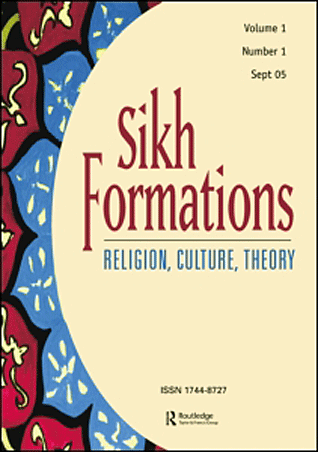Columnists
"Sikh Formations" -
Charting a New Course
by MANJYOT KAUR
The field of Sikh Studies stands at a major turning point. Its "leading lights" of the 1960s and 1970s are gradually ceding the path to new voices, with global and interdisciplinary mindsets.
As old certainties are being reassessed and giving way to fresh modes of thought, the need for academic renewal in this area is great. To reinvigorate a discipline that, in the view of many, has suffered serious neglect in the past two decades, and to set the agenda for the study of Sikhs and Sikhi in the future, a dynamic and ground-breaking journal was launched in the spring of 2005: Sikh Formations.
Published semi-annually by the Taylor & Francis Group Ltd. in the U.K., its masthead of editors and advisors, led by Arvind-Pal Singh Mandair of the University of Michigan at Ann Arbor, is chock-full of the field's "heavyweights".
Right from the start - in the first article of Volume One, Number One! - the prominent and distinguished scholars of its editorial team began to wrestle with the dilemmas Sikh Studies now faces.
They opine that if it were to become trapped in a rubric of the purely theological variety, its ability to intersect with, and thus contribute to, mainstream research in the humanities and social sciences would be severely compromised. Invariably, it would be relegated to the status of a "marginalized asylum-seeker", or that of an exotic, ancient artifact, periodically dusted off at the whim of a curious observer and then, just as casually, replaced on the shelf.
They also believe it must confront other, equally thorny problems. In the interests of intellectual "purity" and objectivity, must the scholar in this field who is a member of the Sikh faith downplay his or her religious identity? Must the non-Sikh scholar deny being affected by the experience of encountering Sikhs and Sikhi?
Such obfuscation only serves to widen the age-old chasm, found in the biased view still held by some, that what is "Western" is central to serious scholarship, and what is "non-Western" is peripheral to it.
In an insightful example of literally "radical" thinking, the editors cogently demonstrate that solutions may lie in the very etymology of the words "Sikh" (a learner or student) and "Sikhi" (the constant process of learning and becoming).
Accepting that the questions of "What does it mean to be a Sikh?" and "What is Sikh Studies?" need not be given definitive, carved-in-stone answers is, in their opinion, the key to both charting a fresh starting point for Sikh Studies and firmly situating it within the framework of rigorous academic scholarship.
According to them, realizing that "religion", "culture" and "theory" (the terms which, not at all coincidentally, comprise Sikh Formations' subtitle) are intrinsically interlinked, and that their confluence is an integral component of Sikh Studies, constitutes an effective, "open-door" approach to interacting with - as well as meaningfully impacting - the ever-evolving disciplines of the humanities and social sciences, in relevant and innovative ways.
This opening editorial piece serves up a tantalizing appetizer to the sumptuous cerebral feast that follows in the four issues of Sikh Formations that have, to date, appeared.
From the initial issue of June 2005 onwards, no time has been wasted in fulfilling the journal's stated mission. This includes to "define a new cultural and intellectual space for Sikhs and Sikhism, both within Punjab and the emerging diaspora"; to "promote enquiry into and critical reflection upon the cultural, philosophical, religious, historical and political developments within Sikhism"; and to "examine the dialogue and inter-religious relations between Sikhism and other world spiritual traditions".
Here's a tempting sample of what Sikh Formations has been offering in its veritable "smorgasbord for the mind".
An eye-catching photo essay, depicting Kar Seva at Harmandar Sahib (cleaning the sacred pool, or sarovar, that surrounds Amritsar's Golden Temple) by Gurmit Singh Virdee; a comprehensive perspective on the development of Sikh Studies over the past four decades, full of personal reminiscences, from the pen of Christopher Shackle; and a vichaar-provoking look of the many facets of the Sikh-turban relationship, written by Virinder Singh Kalra, appeared on June 2005's "list of specials".
A frank assessment of British Sikhs as the pioneers of multiculturalism in the U.K. by Gurharpal Singh; an insightful "re-memory" of Sikh scripture from the female scholarly perspective by Nikki-Guninder Kaur Singh; and a well-balanced review by Sunit Singh of Doris Jakobsh's book, Relocating Gender in Sikh History, were among the items on the "menu" for December 2005.
June 2006 brought a satisfying serving of articles originally presented at an international conference held in May 2004, "Remembering and Forgetting: Memory and Trauma in Recent Sikh and Punjabi Experience", commemorating the then-upcoming 20th anniversary of the Indian Army's 1984 attack on Harmandar Sahib. N.G. Barrier, Darshan Singh Tatla, and Rita Verma were among the noted contributors.
Cinema enthusiasts got a treat during December 2006, as pieces highlighting Sikh-themed films topped the "bill of fare": Pal Ahluwalia's take on "My Mother India"; Harleen Singh's examination of "Maachis" and "Hawayein"; and Jaspal Kaur Singh's encounter with "Maachis" and "Tamas".
Future initiatives, as projected by the journal's editors, show every evidence of being equally mouthwatering. Among them are the introduction of interviews with musicians, politicians and leading intellectuals in the field of Sikh Studies, and the creation of a "Topics" column, highlighting current events and controversies impacting Sikhs worldwide. A "Colloquium" section is also slated to appear, reviewing books and monographs of a cutting-edge nature, paired with responses from the works' own authors.
Sikh Formations is written in a highly sophisticated and erudite style, often providing a mind-bending challenge to even the most learned reader. (Of course, there are some instances of truly dense and impenetrable jargon, the scholarly version of mittha bolna that denizens of "the ivory towers" find so irresistibly sweet to their tongues.)
Like in all academic journals, the articles are prefaced with informative abstracts, and include comprehensive end notes and references. Quotes from Gurbani always receive adequate translation, a much-needed and appreciated addition for a considerable segment of this journal's diverse audience.
Admittedly, as is true with all recently-launched efforts, there are the inevitable rough edges. More than once, specific articles, mentioned as part of the contents of upcoming issues, subsequently did not appear as scheduled. Even if these discrepancies were wholly unavoidable, some follow-up information or other explanation should have nevertheless been provided. It must also be noted that closer editorial attention to details of grammar and syntax would be a welcome enhancement to the overall readability of this journal.
All these types of glitches might simply be considered regrettable, but understandable, in magazines of a non-academic nature. They are unacceptable, however, in scholarly publications, which must be held to more rigorous standards. It is to be hoped that these shortcomings were simply part of the normal "growing pains" all new ventures experience, and that they have already been satisfactorily remedied.
These caveats aside, Sikh Formations is a tremendously exciting initiative of enormous promise. The appearance of a publication that delves so deeply and insightfully into such a wide range of issues of Sikh significance is truly cause for much celebration.
But, while it is indeed splendid to see it take its rightful place among other scholarly journals, its appeal is by no means limited to academia. All who wish to partake of the intellectual delights exploring Sikhi unfailingly provides, will find a satiating feast in the pages of Sikh Formations.
Conversation about this article
1: Jaipal Singh Soor (Newport, U.K.), June 15, 2007, 2:59 PM.
A very interesting overview. It seems a very good publication from what you describe. I am surprised not many people know about it; this is the first time I've ever heard about it. And never hear anyone else mention it. To the editors of "Sikh Formations": Please do us - and yourselves - a favour by advertising it properly.
2: Perminder Kaur (U.K.), January 19, 2009, 12:13 PM.
Seems like an interesting and a very useful publication. I have never seen it or heard of it, is it still in existence? If so, I would like to know where to get hold of it. [Editor: You can subscribe for it at http://www.tandf.co.uk/Journals/titles/17448727.asp]






